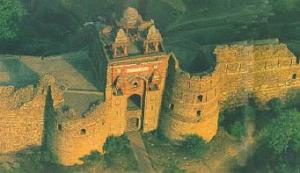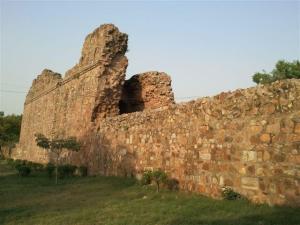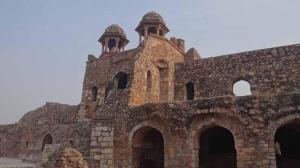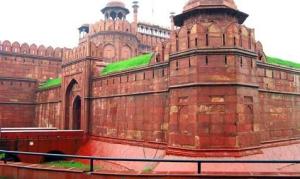On a lazy Sunday morning I had the pleasure of catching up with an old friend in Chandni Chowk. Over a cup of garam chai and jeera biscuits we gossiped about old times and wonderful memories. What started as a gupshup about the wonders of tea and its almost divine effects on the senses metamorphosed into an engaging conversation of the lost moments of Delhi’s cultural extravaganza and its rich heritage! It is interesting how the conversation led us to the City of Indra or Indraprastha. With each sip we were drawn deeper into the wondrous revelations about the past of this magical ancient city!
The ancient Indian scripture of Mahabharata talks about Delhi as Indraprastha, the legendary city built around river Yamuna in Kandava van by Pandavas as early as 800 B.C. It is said that Purana Qila stands in the same place where the city of Indraprastha once existed. I can’t help but wonder what Indraprastha looked like and what its grandeur would have been in those times!
It is said that Delhi as it stands today is an amalgamation of several historic cities built by different rulers from time to time. Delhi was plundered innumerable times and forts were built one after the other to protect it from notorious invaders and monarchs. Though most of the cities have been reduced to rubbles and are lost in the sand’s of time, however some still stand strong refusing to give up!
FIRST CITY: INDRAPRASTHA
Historical logs suggest that out of Delhi’s 9 ancient cities Indraprastha is the first and the oldest city. After winning the epic battle of Mahabharata, Pandavas chose Indraparstha as their capital and built a massive fort here. Purana Qila was built by the Afghan ruler Sher Shah Suri. Archeologists believe that it was built on the remains of the ancient city of Indraprastha.
The ancient Indian scripture of Mahabharata talks about Delhi as Indraprastha, the legendary city built around river Yamuna in Kandava van by Pandavas as early as 800 B.C. It is said that Purana Qila stands in the same place where the city of Indraprastha once existed. I can’t help but wonder what Indraprastha looked like and what its grandeur would have been in those times!
It is said that Delhi as it stands today is an amalgamation of several historic cities built by different rulers from time to time. Delhi was plundered innumerable times and forts were built one after the other to protect it from notorious invaders and monarchs. Though most of the cities have been reduced to rubbles and are lost in the sand’s of time, however some still stand strong refusing to give up!
FIRST CITY: INDRAPRASTHA
Historical logs suggest that out of Delhi’s 9 ancient cities Indraprastha is the first and the oldest city. After winning the epic battle of Mahabharata, Pandavas chose Indraparstha as their capital and built a massive fort here. Purana Qila was built by the Afghan ruler Sher Shah Suri. Archeologists believe that it was built on the remains of the ancient city of Indraprastha.
Purana Qila, Image source: https://travelguideindia.wordpress.com/2007/09/02/purana-qilanew-delhi/
SECOND CITY: QILA RAI PITHORA
Qila Rai Pithora or Lal Kot is the second lost city of Delhi which was gifted to Prithviraj Chuahan by his grandfather. It is said that his ancestors captured it from Rajput ruler, Anangpal who first built the fort at Lal Kot. Chauhan later extended the walls into his city of Rai Pithora.
Qila Rai Pithora or Lal Kot is the second lost city of Delhi which was gifted to Prithviraj Chuahan by his grandfather. It is said that his ancestors captured it from Rajput ruler, Anangpal who first built the fort at Lal Kot. Chauhan later extended the walls into his city of Rai Pithora.
Qila Rai Pithora, Image source: http://im.timescitycontent.com/blog/wp-content/uploads/2013/11/raipithorafin.jpg
THIRD CITY: SIRI
The third lost city of Siri has its own story! The fort of Siri was built during the times of Khilji Dynasty to protect Delhi from Mongol rulers. It is suggested that it existed between the stretch covering Qila Rai Pithora and Indraprastha. Some of the buildings that still exist in and around the fort are Tohfewala Gumbad, Mohemmadewali Masjid, Thanewala Gumbad and Bagh-i-Alam ka Gumbad.
Walls of Siri Fort, Image Source: http://www.socialmantra.in/site-assets/images/somdeb%20-%20close%20shot%20siri%20wall%203.jpg
FOURTH CITY: TUGHLAQABAD
The cities of Tughlaqabad, Jahanpanah and Firozabad were ruled by the emperors of Tughlaq Dynasty. The township of Tughlaqabad, situated between the Faridabad and Delhi border, was established by the fearsome ruler Ghiyasuddin Tughlaq.
The ruins of Tughlaqabad, Image source: https://sahapedia.files.wordpress.com/2011/09/tughlaqabad-13.jpg
FIFTH CITY: JAHANPANAH
Fifth lost city of Delhi, Jahapanah which is Persian for “Shelter for the whole World”, was built by Mohammad Bin Tughlaq covering the cities of Siri and Lal Kot. Bin Tughlaq decided to build a new city away from Tughlaqabad and the Adilabad fort which lies in ruins today was constructed here.
Remains of the City of Jahanpanah, Image source: http://www.socialmantra.in/site-assets/images/somdeb%20-%20close%20shot%20siri%20wall%203.jpg
SIXTH CITY: FIROZABAD
Moving his capital towards northern area of Indraprsatha, Firoz Shah Tughlaq built the city of Firozabad. Some of the beautiful mosques reminiscent of these times are Khirki Masjid, Kalu-Sarai-Ki Masjid, Begum Masjid, Kalan Masjid, Jami Masjid or Firoz Shah Kotla and Chausath Khamba Masjid.
Ruins of Firoz Shah Kotla, Image Source: http://nomadicrider.com/wp-content/uploads/2011/01/2.Ruins-the-FerozShah-Kotla.jpg
SEVENTH & EIGHTH CITIES: DEENPANAH & DILLI SHER SHAHI
City of Deenpanah marks the advent of Mughal Sultanate in Delhi. Mughal emperor Humayun thought of building the city between the area marking Khizrabad and Indraprastha. However, before he could execute his plans he was overthrown by Sher Shah Suri. On the area marked for Deenpanah, he built his own city and called it Dilli Sher Shahi. The fort of Shergarh was the citadel of the city.
Humayun Darwaza at Shergarh, Image source: http://www.ghumakkar.com/wp-content/uploads/2013/03/Humayun-Darwaza.jpg
NINTH CITY: SHAHJAHANABAD
Delhi saw its 30 years of glory during the reign of Mughal emperor Shahjahan who built the city of Shahjahanabad or Old Delhi, covering the major portions of Dilli Sher Shahi and Firozabad. Shifting his capital from Agra to Shahjahanbad, he started massive constructions in Delhi and Agra. Qila-e-Mubarak or Red Fort, the myriad and bright bazaars of old Delhi like Chandni Chowk; and the seven glorious gates (Kashmiri gate, Mori gate, Ajmeri gate, Lahori gate, Kabul gate, Faresh Khana Gate, Turkman Gate and Calcutta Gate) are a proof of the city’s glorious past during Shahjahan’s rule.
Qila –e-Mubarak or Red Fort at Shahjahanabad, Image Source: http://www.sodelhi.com/media/reviews/photos/original/c0/ce/b4/174_sodelhi-shahjahanabad03-1346409603.jpg
Lutyen’s Delhi or New Delhi marks the end of Mughal reign. The British destroyed most of what Shahjahan had built and renamed the Mughal monuments after British viceroys. Edwin Lutyen was a British Architect who planned all the major constructions in Delhi during British Raj. Introducing the concept of urban architecture, Lutyen’s Delhi saw the last bit of major constructions being done in Delhi. Cannuaght place, India Gate, Rashtrapati Bhawan and Parliament are all examples of the magnificent contribution by the British in terms of architecture in Delhi.
Rashtrapati Bhavan, Image Source: http://presidentofindia.nic.in/Images/visit-to-rashtrapati-bhavan-img.jpg
I believe Delhi is immortal! The wonders of Indraprastha are and will remain immeasurable. Each of the 9 lost cities bears a testimony to the era that Delhi has witnessed. The remains of the monuments from each city are a symbol of Delhi’s rich heritage. Every monument tells its own story. There is a need not just to preserve them but to motivate today’s generation to realize their value as well!









No comments:
Post a Comment